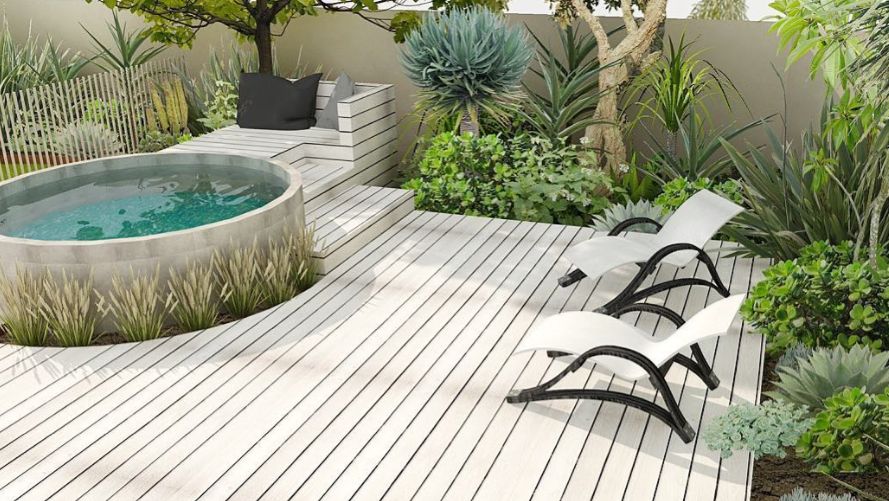Why you might want to consider getting your own plunge pool
If you’ve been dreaming of having a pool in your backyard, but feel like you don’t have the space or the budget, you might want to consider a plunge pool. Basically a smaller version of their larger, in-ground counterparts, plunge pools can range in size, shape and style, with most averaging around just 13–22 feet in length and 6–10 feet in width.
The advantages of a plunge pool over a regular-sized pool are simple: Because of their small size, you’ll likely spend less money up front for installation. They’re also more affordable to maintain because, hey, you’ll have less pool to clean, fill and add chemicals to.
And when we say they can be small, we’re not kidding. Just look at how eensy weensy but also super pretty this plunge pool is that destination wedding planner Regine Danielle posted on her Instagram:
https://www.instagram.com/p/BX1bYQFAEqU/?tagged=plungepool
So How Much Do They Cost?
The price of in-ground pools can vary greatly depending upon several factors. Obviously, size plays a big role in cost and, the larger and deeper a pool is, the more costly it becomes. According to HomeAdvisor, the average price of a standard-sized, in-ground pool in 2017 ranges somewhere between $33,636 to $57,858. But though the prices of plunge pools also vary quite a bit, they seem to fall in the range of around $20,000 to $25,000. This is primarily due to their smaller size.
Still, materials used, the design of your pool and even the cost of living in the area where the pool is being built need to be factored in. So if you’re going for a big wow factor (fancy-pants water feature, anyone?), that can certainly bump up the cost.
To confirm these findings, I spoke with Brian Eilerman, a pool expert who works for Riley Pools & Spa in Cincinnati, Ohio. He explained to me that there are three different ways to construct pools: with a vinyl liner, which is the most cost-efficient, with a fiberglass insert or, with concrete (like this one below, which exterior designer Ascher Smith posted to Instagram), which is the most expensive route (but so pretty!):
https://www.instagram.com/p/BW7U9-3njaq/
In the case of vinyl-lined pools, Eilerman said that those who install smaller pools, such as a plunge pool, will save money on everything from the construction to the cost of materials, as well as maintenance throughout the years. He explained that, while the average cost of an in-ground pool can range anywhere from $35k to $45k in his area, in the case of plunge pools, the average cost of installation significantly drops. “I’d say the average cost of a smaller pool would be between $15k to $20k,” said Eilerman.
To get an idea of what it might cost to install an in-ground pool in your location, the website PoolPricer has a helpful tool anyone can use. The tool can tell you the average cost for a pool in your area, as well as other things that need to be considered, such as state laws around owning a pool, and whether or not you’ll need permits from your county or state. And while you can’t specify on the site that you’re pricing out a plunge pool, if you go the vinyl liner route, you can expect to pay less the smaller the pool is.
You Can Also DIY To Save Even More Money
If you’re looking for an even more cost effective way to install an in-ground plunge pool, there is the option to purchase a pool kit. Just keep in mind that, if you decide to go this route, you’ll likely need to hire an excavator to dig and haul away the dirt. You’ll probably also want to also hire an electrician to ground the pool. And the time it would take to install everything yourself could run you days, if not weeks. This video posted by YouTuber jmcnei002 will give you an idea of what you could be in for:
Other Costs To Factor In
Plunge pools can be a great, more affordable choice over the standard-sized, in-ground pool, but with any type of pool, regardless of size, you still need to consider other costs. For example, do you need a fence around it? Are you planning to keep the plunge pool open year-round? Because if so, you’ll need to equip it with a water heater. You’ll also need a cover for it.
And if you’re looking to have the plunge pool complement an outdoor living area and garden, don’t forget to add in the cost of a patio or deck, and maybe some nice landscaping for privacy.
In fact, considering the number of options out there, you might want to do a little “research” before taking the plunge, as in testing out plunge pools before purchasing one. If so, here’s a fun list of 10 Caribbean resorts that offer guests their very own private plunge pools.
Or if all of this just seems like too much to think about, you can always just opt for a ModPool made out of a shipping container, or a Stock Tank pool.
But those plunge pools, though…


